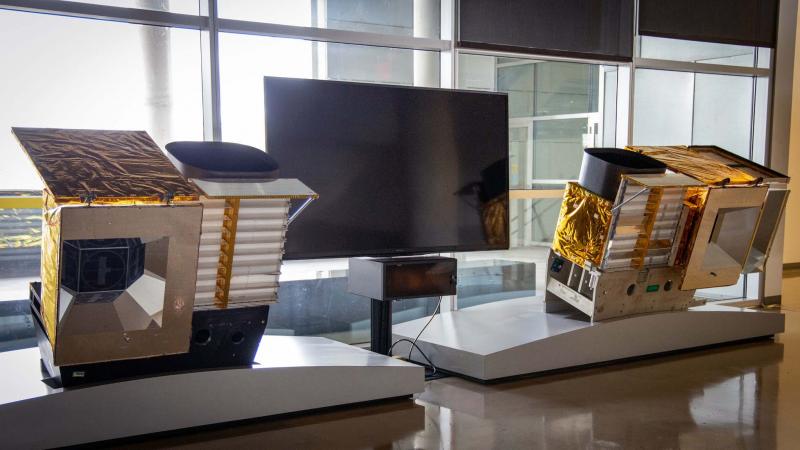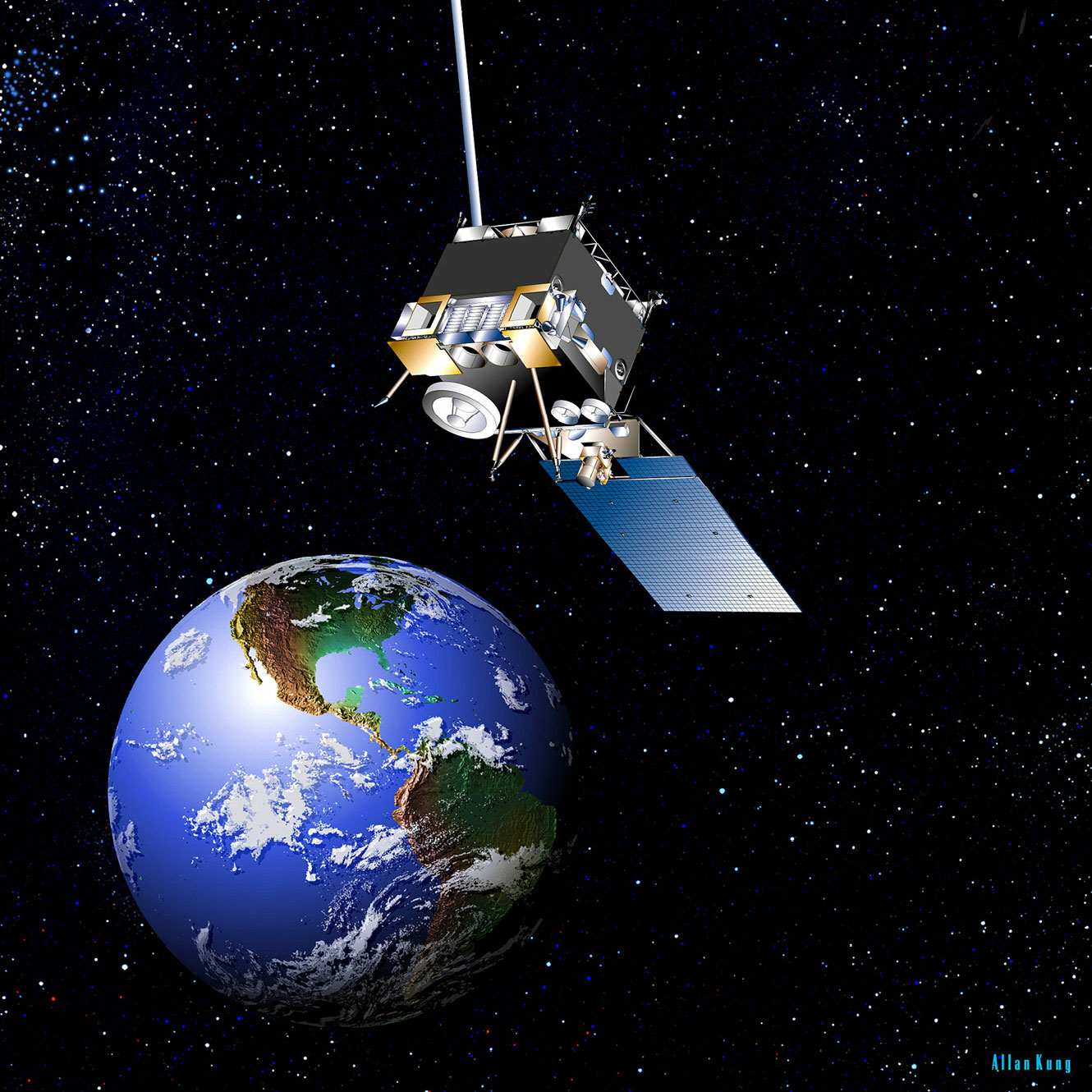Weather Satellite’s Instruments Find a Home at the Smithsonian
Special Stories
19 Nov 2020 1:00 AM
[A model of the GOES N,O, and P satellites in the lobby of NOAA’s Satellite Operations Facility (NSOF) in Suitland, MD. It is not to scale. (Photo credit: Andre Hammond of OSPO at NSOF)]
[Written by NOAA] NOAA’s Geostationary Operational Environmental Satellites (GOES) have a long history of monitoring the Earth’s ever-changing weather from above. Now, some of that history will be put on display at the Smithsonian’s Air and Space Museum in Washington, DC.
Two instruments from GOES-Q have been sitting in storage for years, essentially collecting dust instead of weather data. GOES-Q was originally designed to be part of a group of four fourth-generation GOES satellites called the GOES-N series (which included GOES N, O, P, and Q) that were slated to be built and then launched between 2006 and 2010. During development, GOES satellites are sequentially lettered, but once launched and operational in space, they are renamed and given a numerical designation. Thus GOES N, O, and P later became known as GOES-13, -14, and -15 respectively.
 [Models of the imager (left) and sounder (right) instruments found on the GOES N,O, and P satellites in the lobby of NOAA’s Satellite Operations Facility (NSOF) in Suitland, MD. The actual instruments originally intended for GOES-Q look identical. (Photo credit: Andre Hammond of OSPO at NSOF)]
However, because the existing satellites were performing well past their expected lifetimes, construction of the GOES-Q satellite was cancelled in 2002 after its flight imager and sounder were already manufactured. The imager was designed to capture imagery of the planet from above, and the sounder was designed to collect information about the temperature, pressure, water vapor, and critical trace gasses throughout the atmosphere. These instruments were exact duplicates of those already on board GOES N, O, and P, and served as flight-qualified spares, should a need arise, while the other satellites were being built. But, upon the successful launch of GOES R (GOES-16) in 2016—the first of a new, more advanced generation of satellites (the GOES-R series)—the GOES-Q instruments were no longer needed as backups.
Although these two instruments from GOES-Q never found a home in space, they did find a home where they will still be treasured by the world. This year they were retired to the National Collection of the Smithsonian Institute, where they will be incorporated into two modernized exhibits that are being constructed at the Air and Space Museum, which is currently undergoing a major seven-year renovation.
[Models of the imager (left) and sounder (right) instruments found on the GOES N,O, and P satellites in the lobby of NOAA’s Satellite Operations Facility (NSOF) in Suitland, MD. The actual instruments originally intended for GOES-Q look identical. (Photo credit: Andre Hammond of OSPO at NSOF)]
However, because the existing satellites were performing well past their expected lifetimes, construction of the GOES-Q satellite was cancelled in 2002 after its flight imager and sounder were already manufactured. The imager was designed to capture imagery of the planet from above, and the sounder was designed to collect information about the temperature, pressure, water vapor, and critical trace gasses throughout the atmosphere. These instruments were exact duplicates of those already on board GOES N, O, and P, and served as flight-qualified spares, should a need arise, while the other satellites were being built. But, upon the successful launch of GOES R (GOES-16) in 2016—the first of a new, more advanced generation of satellites (the GOES-R series)—the GOES-Q instruments were no longer needed as backups.
Although these two instruments from GOES-Q never found a home in space, they did find a home where they will still be treasured by the world. This year they were retired to the National Collection of the Smithsonian Institute, where they will be incorporated into two modernized exhibits that are being constructed at the Air and Space Museum, which is currently undergoing a major seven-year renovation.
 [GOES-N concept art. (Image credit: NASA Goddard Space Flight Center)]
The GOES-Q sounder will be placed into a new exhibit on climate change that is slated to open in 2023. Its imager will be placed into a new gallery called “Living in the Space Age,” which looks at the many ways space technologies enter into our daily life. It is expected to open in 2025. These instruments will be joining other significant NOAA artifacts, including a Microwave Sounder Unit (MSU) that had been a spare for an earlier polar-orbiting satellite that was transferred to the Smithsonian in 2004. This MSU will become part of an exhibit entitled “One World Connected,” tentatively scheduled to open in late 2022.
NOAA’s GOES satellites are positioned roughly 22,300 miles above the Earth’s surface and orbit the planet at the same speed that it rotates. They are able to continuously monitor weather over a specific area, providing information that is used for short-term (1–2 day) forecasts as well as for tracking storm systems in real-time. They also monitor solar activity (space weather) and aid in search and rescue efforts for people in distress. The first GOES satellite was launched in 1975, and as technology has advanced, more advanced versions have been built and sent into space.
[GOES-N concept art. (Image credit: NASA Goddard Space Flight Center)]
The GOES-Q sounder will be placed into a new exhibit on climate change that is slated to open in 2023. Its imager will be placed into a new gallery called “Living in the Space Age,” which looks at the many ways space technologies enter into our daily life. It is expected to open in 2025. These instruments will be joining other significant NOAA artifacts, including a Microwave Sounder Unit (MSU) that had been a spare for an earlier polar-orbiting satellite that was transferred to the Smithsonian in 2004. This MSU will become part of an exhibit entitled “One World Connected,” tentatively scheduled to open in late 2022.
NOAA’s GOES satellites are positioned roughly 22,300 miles above the Earth’s surface and orbit the planet at the same speed that it rotates. They are able to continuously monitor weather over a specific area, providing information that is used for short-term (1–2 day) forecasts as well as for tracking storm systems in real-time. They also monitor solar activity (space weather) and aid in search and rescue efforts for people in distress. The first GOES satellite was launched in 1975, and as technology has advanced, more advanced versions have been built and sent into space.
 [Models of the imager (left) and sounder (right) instruments found on the GOES N,O, and P satellites in the lobby of NOAA’s Satellite Operations Facility (NSOF) in Suitland, MD. The actual instruments originally intended for GOES-Q look identical. (Photo credit: Andre Hammond of OSPO at NSOF)]
However, because the existing satellites were performing well past their expected lifetimes, construction of the GOES-Q satellite was cancelled in 2002 after its flight imager and sounder were already manufactured. The imager was designed to capture imagery of the planet from above, and the sounder was designed to collect information about the temperature, pressure, water vapor, and critical trace gasses throughout the atmosphere. These instruments were exact duplicates of those already on board GOES N, O, and P, and served as flight-qualified spares, should a need arise, while the other satellites were being built. But, upon the successful launch of GOES R (GOES-16) in 2016—the first of a new, more advanced generation of satellites (the GOES-R series)—the GOES-Q instruments were no longer needed as backups.
Although these two instruments from GOES-Q never found a home in space, they did find a home where they will still be treasured by the world. This year they were retired to the National Collection of the Smithsonian Institute, where they will be incorporated into two modernized exhibits that are being constructed at the Air and Space Museum, which is currently undergoing a major seven-year renovation.
[Models of the imager (left) and sounder (right) instruments found on the GOES N,O, and P satellites in the lobby of NOAA’s Satellite Operations Facility (NSOF) in Suitland, MD. The actual instruments originally intended for GOES-Q look identical. (Photo credit: Andre Hammond of OSPO at NSOF)]
However, because the existing satellites were performing well past their expected lifetimes, construction of the GOES-Q satellite was cancelled in 2002 after its flight imager and sounder were already manufactured. The imager was designed to capture imagery of the planet from above, and the sounder was designed to collect information about the temperature, pressure, water vapor, and critical trace gasses throughout the atmosphere. These instruments were exact duplicates of those already on board GOES N, O, and P, and served as flight-qualified spares, should a need arise, while the other satellites were being built. But, upon the successful launch of GOES R (GOES-16) in 2016—the first of a new, more advanced generation of satellites (the GOES-R series)—the GOES-Q instruments were no longer needed as backups.
Although these two instruments from GOES-Q never found a home in space, they did find a home where they will still be treasured by the world. This year they were retired to the National Collection of the Smithsonian Institute, where they will be incorporated into two modernized exhibits that are being constructed at the Air and Space Museum, which is currently undergoing a major seven-year renovation.
 [GOES-N concept art. (Image credit: NASA Goddard Space Flight Center)]
The GOES-Q sounder will be placed into a new exhibit on climate change that is slated to open in 2023. Its imager will be placed into a new gallery called “Living in the Space Age,” which looks at the many ways space technologies enter into our daily life. It is expected to open in 2025. These instruments will be joining other significant NOAA artifacts, including a Microwave Sounder Unit (MSU) that had been a spare for an earlier polar-orbiting satellite that was transferred to the Smithsonian in 2004. This MSU will become part of an exhibit entitled “One World Connected,” tentatively scheduled to open in late 2022.
NOAA’s GOES satellites are positioned roughly 22,300 miles above the Earth’s surface and orbit the planet at the same speed that it rotates. They are able to continuously monitor weather over a specific area, providing information that is used for short-term (1–2 day) forecasts as well as for tracking storm systems in real-time. They also monitor solar activity (space weather) and aid in search and rescue efforts for people in distress. The first GOES satellite was launched in 1975, and as technology has advanced, more advanced versions have been built and sent into space.
[GOES-N concept art. (Image credit: NASA Goddard Space Flight Center)]
The GOES-Q sounder will be placed into a new exhibit on climate change that is slated to open in 2023. Its imager will be placed into a new gallery called “Living in the Space Age,” which looks at the many ways space technologies enter into our daily life. It is expected to open in 2025. These instruments will be joining other significant NOAA artifacts, including a Microwave Sounder Unit (MSU) that had been a spare for an earlier polar-orbiting satellite that was transferred to the Smithsonian in 2004. This MSU will become part of an exhibit entitled “One World Connected,” tentatively scheduled to open in late 2022.
NOAA’s GOES satellites are positioned roughly 22,300 miles above the Earth’s surface and orbit the planet at the same speed that it rotates. They are able to continuously monitor weather over a specific area, providing information that is used for short-term (1–2 day) forecasts as well as for tracking storm systems in real-time. They also monitor solar activity (space weather) and aid in search and rescue efforts for people in distress. The first GOES satellite was launched in 1975, and as technology has advanced, more advanced versions have been built and sent into space.All Weather News
More